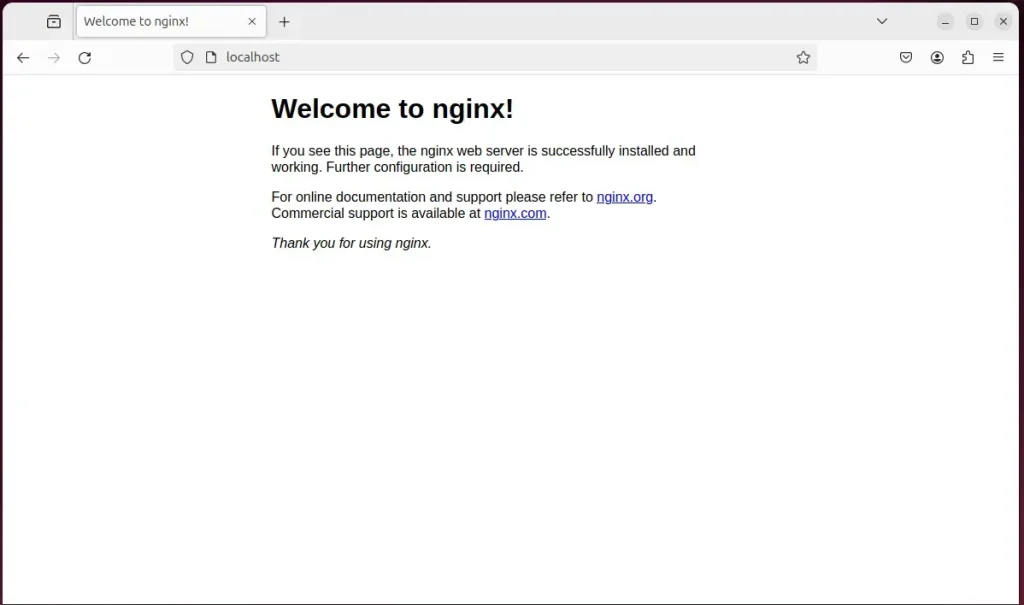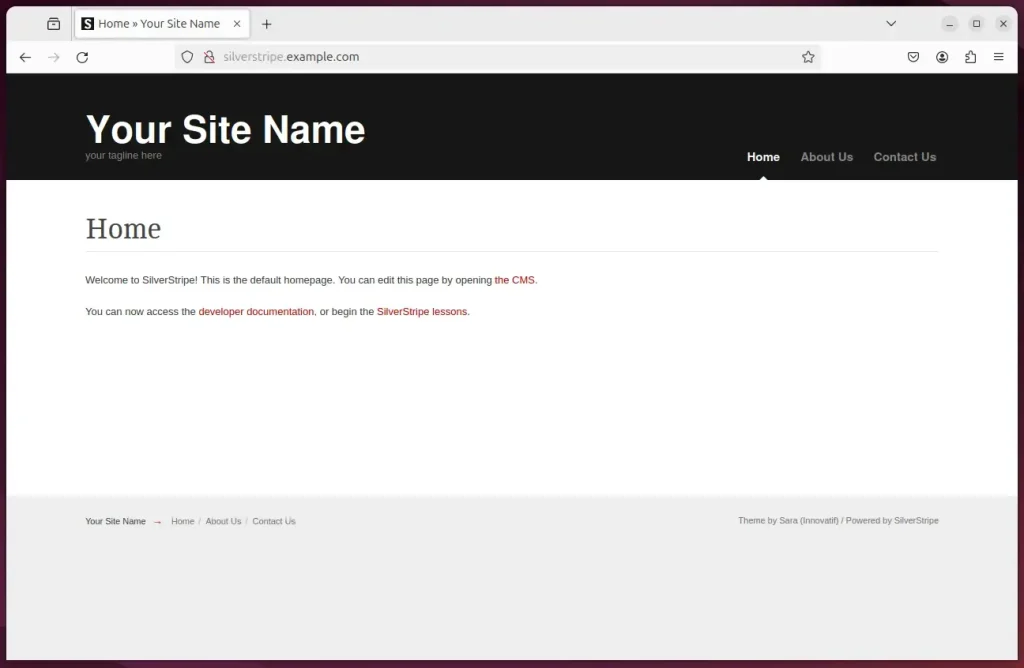This article explains how to install SilverStripe CMS with Nginx on Ubuntu 24.04.
SilverStripe CMS is a powerful and flexible content management system, and Nginx is a high-performance web server. When combined, they form a robust platform for hosting web applications. This guide will walk us through installing SilverStripe CMS with Nginx on Ubuntu.
By the end of this tutorial, you will have a fully operational SilverStripe CMS running on a secure and efficient Nginx web server. Let’s dive in and get started with the installation process.
Install Nginx HTTP server on Ubuntu
SilverStripe CMS requires a web server. This post will install and use the Nginx web server to run SilverStripe.
To do that, open the Ubuntu terminal and run the commands below to install the Nginx web server.
sudo apt update
sudo apt install nginx
Once Nginx is installed, the commands below can start, stop, and enable the Nginx web server to start automatically when your server boots up.
sudo systemctl stop nginx
sudo systemctl start nginx
sudo systemctl enable nginx
You can test the Nginx web server by opening your web browser and browsing to the server’s localhost or IP address.
http://localhost

When you see “Welcome to nginx!” the Nginx HTTP server has been installed.
Additional help on installing Nginx on Ubuntu is in the link below.
How to install Nginx on Ubuntu
Install the MariaDB database server on Ubuntu
The next component required to run SilverStripe is a database server. This post will install and use the MariaDB database server.
To install and use the MariaDB database server, use the instructions below.
Open the Ubuntu terminal and run the commands below to install the MariaDB database server.
sudo apt update sudo apt install mariadb-server
Once the MariaDB database server is installed, use the commands below to stop, start, and enable the MariaDB server to start automatically when the server boots.
sudo systemctl stop mariadb sudo systemctl start mariadb sudo systemctl enable mariadb
Run the following commands to validate and test if the MariaDB database server is installed successfully.
sudo mariadb
Once you run the commands above, it will log you onto the MariaDB console and display a message similar to the one below.
Welcome to the MariaDB monitor. Commands end with ; or \g. Your MariaDB connection id is 32 Server version: 10.11.2-MariaDB-1 Ubuntu 23.04 Copyright (c) 2000, 2018, Oracle, MariaDB Corporation Ab and others. Type 'help;' or '\h' for help. Type '\c' to clear the current input statement. MariaDB [(none)]>
The message tells you that the server is installed successfully.
Additional help on installing MariaDB.
Create a SilverStripe database
Upon successful installation of the MariaDB database server, create a blank database on the server specifically for the SilverStripe application.
As part of the setup, we will create a silverstripedb database and a corresponding user account called silverstripedbuser.
Finally, we’ll grant the silverstripedbuser full access to the silverstripedb database.
All the database steps above can be done using the commands below:
But first, log on to the MariaDB database server:
sudo mariadb
Then run the commands below to complete the steps:
CREATE DATABASE silverstripedb CHARACTER SET utf8mb4 COLLATE utf8mb4_general_ci;
CREATE USER silverstripedbuser@localhost IDENTIFIED BY 'type_your_password_here';
GRANT ALL ON silverstripedb.* TO silverstripedbuser@localhost WITH GRANT OPTION;
FLUSH PRIVILEGES;
exit
Ensure to replace ‘type_your_password_here ‘with your password.
Install PHP-FPM on Ubuntu Linux
The last component you will need to run SilverStripe is PHP-FPM. The SilverStripe application is PHP-based and supports the latest versions of PHP-FPM.
Run the commands below to install PHP-FPM.
sudo apt install php-fpm php-intl php-mysql php-curl php-cli php-zip php-xml php-gd php-common php-mbstring php-xmlrpc php-json php-sqlite3 php-soap php-zip
Additional help on installing PHP
How to install PHP on Ubuntu Linux
Download SilverStripe files
Let’s begin downloading and configuring the SilverStripe files on Ubuntu Linux.
You may want to use the GitHub repository to get SilverStripe’s latest release. To get started, install Composer, Curl, and other dependencies.
sudo apt install curl git curl -sS https://getcomposer.org/installer | sudo php -- --install-dir=/usr/local/bin --filename=composer
After installing curl and Composer above, change the directory to the Nginx root directory and download the SilverStripe packages from Github.
cd /var/www/
sudo composer create-project silverstripe/installer silverstripe
Now create a .env file in your project root (not the public/ folder).
If you used silverstripe/installer to create your project, you can rename the .env.example file to .env. It includes the minimum required environment variables.
sudo nano /var/www/silverstripe/.env
Replace the placeholders as required:
SS_DATABASE_CLASS="MySQLDatabase"
SS_DATABASE_NAME="silverstripedb"
SS_DATABASE_SERVER="localhost"
SS_DATABASE_USERNAME="silverstripedbuser"
SS_DATABASE_PASSWORD="type_database_password"
SS_DEFAULT_ADMIN_USERNAME="superadmin"
SS_DEFAULT_ADMIN_PASSWORD="superadminPassword"
SS_ENVIRONMENT_TYPE="live"
Now, you should be able to build your database and make Nginx owner of the directory by running this command:
sudo /var/www/silverstripe/vendor/bin/sake dev/build
sudo chown -R www-data:www-data /var/www/silverstripe
Once you have completed all the above steps, continue configuring the Nginx web server below to serve the SilverStripe content.
Run the commands below to create a Nginx virtual host file for SilverStripe.
sudo nano /etc/nginx/sites-available/silverstripe.conf
Then, copy and paste the content block below into the Nginx server block.
server {
listen 80;
listen [::]:80;
root /var/www/silverstripe/public;
index index.php;
server_name silverstripe.example.com;
location / {
try_files $uri /index.php?$query_string;
}
location ~ \.php$ {
include snippets/fastcgi-php.conf;
fastcgi_pass unix:/var/run/php/php8.3-fpm.sock;
fastcgi_param SCRIPT_FILENAME $document_root$fastcgi_script_name;
include fastcgi_params;
}
}
Save the file.
Then, run the commands below to enable the virtual host and restart the Nginx server.
sudo ln -s /etc/nginx/sites-available/silverstripe.conf /etc/nginx/sites-enabled/
sudo systemctl restart nginx.service
Setup Let’s Encrypt SSL/TLS for SilverStripe
You may want to install an SSL/TLS certificate to secure your SilverStripe site. Secure your SilverStripe installation with HTTPS from Let’s Encrypt.
Please read the post below for additional resources on installing and creating Let’s Encrypt SSL certificates for Nginx.
How to set up Let’s Encrypt SSL certificate for Nginx on Ubuntu Linux
Once you have restarted the Nginx web server, open your browser and browse to the server hostname or IP address defined in the Nginx server block.
http://silverstripe.example.com
Your SilverStripe site should be set up and ready to use.

That should do it!
Conclusion:
With this comprehensive guide, you have successfully installed and configured SilverStripe CMS with Nginx on Ubuntu. By following each step meticulously, you have set up a powerful and flexible content management system with a high-performance web server, forming a robust platform for hosting web applications. Your SilverStripe site is now operational, secure, and ready to utilize. Cheers to your successful deployment!

Leave a Reply